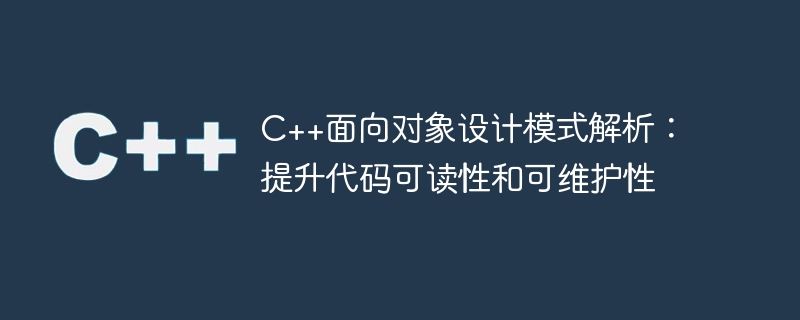
In recent years, with the rapid development of the software development industry, developers have paid more attention to the use of design patterns to improve the readability and maintainability of code. In C object-oriented programming, the application of design patterns is particularly important. This article will analyze object-oriented design patterns from a C perspective to help readers better understand and apply these design patterns.
1. Introduction to Design Patterns
Design patterns are a set of proven solutions for solving specific problems. They are summed up by experienced developers while solving real problems. Design patterns provide a common approach to code organization and structure that can improve code reusability, flexibility, and maintainability.
2. Common design patterns
- Singleton pattern
The singleton pattern is a creation pattern that is used to ensure that a class has only one instance object and provides support for The global access point for this instance. It can effectively realize resource sharing in multi-threaded environment.
- Factory Pattern
The factory pattern is a creational pattern that is used to encapsulate the object creation process so that the client code does not need to care about the specific object creation details. The factory pattern can return instance objects of different classes as needed.
- Observer Pattern
The Observer pattern is a behavioral pattern used to establish a one-to-many dependency relationship between objects. When an object changes, all its dependent objects are notified and updated automatically.
- Strategy Pattern
Strategy pattern is a behavioral pattern that is used to define a series of algorithms and encapsulate them so that the algorithms can be replaced with each other. Strategy mode can select different algorithms based on the runtime environment.
- Command mode
The command mode is a behavioral mode that is used to encapsulate the request into an object, thereby decoupling the sender and receiver of the request. This design method can support both the invocation of requests and the cancellation of requests.
3. Benefits of design patterns
- Improve the readability of code
Design patterns provide a common coding specification, making the code easier to understand. By following design patterns, developers can easily read and understand the code, leading to better maintenance and debugging.
- Improve the maintainability of the code
The design pattern divides the code into different modules and levels to minimize the impact of code changes on other parts. This modular design makes it easier for developers to locate and fix problems in their code.
- Improve code reusability
Design patterns encourage code encapsulation and abstraction, making code easier to reuse. Through design patterns, developers can define common functional units as independent classes or interfaces, so that these functions can be reused in different projects.
4. Precautions for design patterns
- Understanding the problem
Before selecting and applying a design pattern, you first need to fully understand the needs and background of the problem to ensure that all The selected design pattern can effectively solve the problem.
- Don’t overuse design patterns
Design patterns exist to solve specific problems. Don’t use design patterns for the sake of using design patterns. Excessive use of design patterns may increase code complexity and reduce code readability and maintainability.
- Flexible use
Design patterns are not static, they can be flexibly used and adjusted according to the actual situation. Developers should choose the most appropriate design pattern based on specific business needs and code characteristics.
5. Summary
Object-oriented design pattern is an important tool to improve code readability and maintainability. In C programming, the correct selection and application of design patterns can make the code more flexible, efficient, and easier to understand. At the same time, developers also need to pay attention to the correct use and flexible application of design patterns to ensure that the true value of design patterns can be exerted.
The above is the detailed content of C++ object-oriented design pattern analysis: improving code readability and maintainability. For more information, please follow other related articles on the PHP Chinese website!






